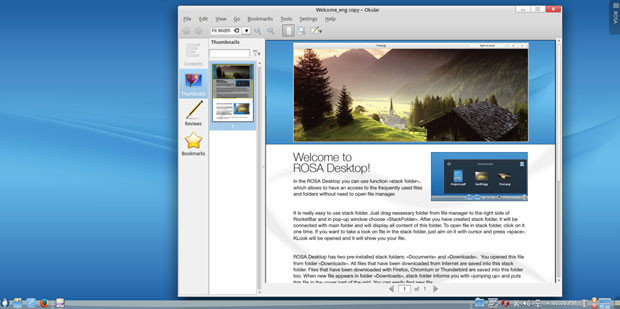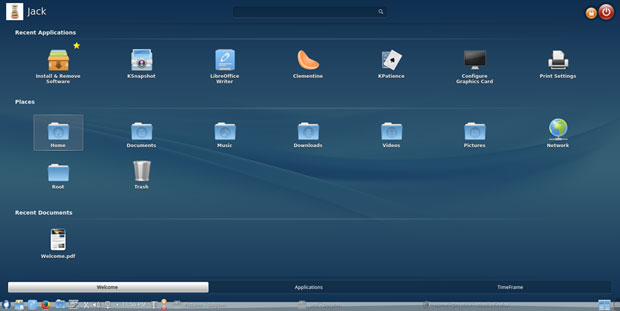
![]()
TheRosa Desktop Fresh R series optimizes desktop usage and targets advanced users and enthusiasts looking for rich functionality. Add to that mix the default KDE flavoring and you have a compelling Linux distro that challenges your first-choice OS.
The typical Rosa user already is familiar with basic Linux offerings and wants a product with a wide set of customization and personalization possibilities. That is what Rosa Desktop delivers.
Rosa is a Russian company with a variety of Linux-based solutions. Its flagship product, Rosa Desktop, is a Linux distribution featuring a highly customized KDE desktop and a number of modifications designed to enhance the user-friendliness of the working environment. The company also develops an Enterprise Server edition of Rosa, which is based on Red Hat Enterprise Linux.
Rosa R7 Desktop came out last month.
Do not misunderstand the nomenclature: Rosa Desktop is not the latest desktop environment to challenge the likes of GNOME 3, Unity, Cinnamon, Elementary or what have you. Rather, it is a very focused distro built around a well-tweaked integration of the K Desktop Environment enhanced with a strict development path that pushes the latest versions of hand-picked Linux packages for optimum performance.
Under the Hood
The Rosa distribution in general is built around the community’s software builds and a developmental environment based on international testing and verification practices. The goal is to constantly monitor the state of the package base to guarantee compatibility of distribution components and complete closure of repositories with respect to package dependencies.
The system contains fresh versions of user software and system components. They include the RPM5 package manager, Systemd initialization daemon, and a Linux kernel with nrj and nrjQL patch sets.
The developers have crammed a collection of ideal components into the Linux engine. For instance, the graphical subsystem is based on X11 with up-to-date proprietary drivers for AMD and Nvidia cards, along with support for hybrid graphics. The system uses the Grub2 boot loader with UEFI support.
It includes popular scripting languages with large sets of modules that include Perl, PHP, Python and Ruby. Developers topped off the tank with up-to-date drivers for printers and scanners of different vendors and added the OpenJDK Java environment.
Delightful Desktop
Rosa Fresh R series is built around the latest version of the K Desktop Environment (4.10) as the main offering, but you can opt for Gnome3 or the lightweight LXDE desktops if you prefer. Each variant is available in its own ISO on the download page.
Rosa development does not stop there, however. The community is focused on a full spectrum of Linux offerings. The Rosa repositories are supplied with packages for LXQt, Mate, Xfce and Enlightenment.
The Rosa community did considerable fine-tuning of the KDE settings. The KDE System Settings configuration tool is enhanced with additional tools that include a domain wizard and a variety of package management programs.

NetworkManager handles the Desktop Fresh network management duties. In KDE, Plasma NetworkManager serves as a graphical front end. Support for VPN, PPTP, connections through mobile devices and other network technologies is available out of the box.
Rosa’s Own Brand
The Rosa distro’s custom software is a big differentiator that sets Rosa apart from other purveyors of Linux, especially those using the KDE flavor.
Some of the Rosa-specific features are turned on by default. Others are widgets you can add to the desktop controls.
A nice touch associated with these Rosa-branded items is a modification to the panel bar across the bottom of the screen. The panel is redesigned to allow bigger icons. This function previously was unavailable for the KDE panel.
Clicking the menu button in the far left bottom panel bar opens a full-screen menu view with three tabbed options along the bottom edge of the menu window. They provide access to Welcome, Applications and TimeFrame. A search window sits at the top of the screen in the Welcome and TimeFrame screens.

This approach is a major change not found in standard KDE integration. Rosa developers abandoned the use of Plasma in the SimpleWelcome menu. This brought a decrease in memory usage and significantly improved speed and stability.
The Welcome menu provides a single launch point for applications arranged by category or functionality. Applications displays all installed programs. TimeFrame is a new content visualization tool that allows you to easily monitor your activity at specified dates and return to those documents with a click.
More to Rave About
KDE has its own rich collection of add-on widgets. The Rosa community adds a few of its own to bring more pointed functionality.
StackFolder, a new KDE applet developed by Rosa Laboratory, lets you organize fast access to frequently used folders and files. Use it to create a stack folder by dragging and dropping from the Dolphin file manager to the panel bar’s right zone.
The Rosa team did some serious modifications to the standard KDE Dolphin file manager. The developers substantially simplified the main toolbar and removed infrequently used elements.
The developers also decreased the amount of information noise the default menu button on the main toolbar displays. Another key change is the structure of the right-click menu, which is now simpler and more logical.
Impressions and Performance Count
Rosa goes in a direction with the KDE desktop that other distributors have not ventured. Some recent KDE tweaks in newly released distros have muted or removed the prominence of the hot corner buttons that activate key KDE features such as Activities.
Rosa’s developers did not eliminate Activities on the desktop. They make its access one of the options in the upper-right corner buttons, along with other system controls.
The bottom right corner button pops up the panel configuration tools and pairs them with the Add Widgets button and a More Settings icon.
Overall, this makes for a very smooth operation. It also simplifies the sometimes overwhelming complexity of KDE.
Software Stronghold
Rosa also does not go overboard stuffing the KDE version with K-era packages when better options are available, so you get essential software, such as the Firefox and Chromium Web browsers, preinstalled.
You also get the Thunderbird mail client, the LibreOffice office suite and the Texlive stack. Rosa Media Player is a default media player.
Rosa includes a set of scientific and educational software, GNU Octave, Maxima, R and a lot of others. A large set of multimedia codecs comes in default installation.
Bottom Line
The Rosa Desktop Fresh R series is one of the most impressive and productive Linux releases I have seen in quite some time. Its performance is top notch.
It gets high marks in all the right places: Installation is flawless, the KDE integration is innovative, and the software is reliable.
KDE is one of the most complex desktop environments, so potential users who are less familiar with the Linux OS should approach the default KDE release with the idea that it is a great computing platform but might not be what they need. Rosa developers offer enough options to meet the skill levels and needs of all user classes.
Want to Suggest a Review?
Is there a Linux software application or distro you’d like to suggest for review? Something you love or would like to get to know?
Pleaseemail your ideas to me, and I’ll consider them for a future Linux Picks and Pans column.
And use the Talkback feature below to add your comments!























































Rosa is fantastic, and anyone who disagrees obviously hasn’t even given it a try. I’m using Mate, and am "thisclose" to totally dumping Windows. I’m tired of being manipulated & controlled by the BigClowns… See my commentat..http://www.open-source-feed.com/2016/01/linux-mint-173-rosa-wilted-flower-review.html..to see what I really mean!
All I can say is "Thank You Linux Contributors for bringinging this main-stream…. Which is a good thing. Time to get off the high-horse of "I’m a Linux User" and learn to play nice and quit complicating things with your make-believe tall-foreheaded-way of thinking!!"
this talks about using the latest KDE, but then says that it’s KDE 4.1, I’m running KDE 5.18 on my laptop, so it’s badly outdated
You are correct. The KDE version for ROSA 7 is 4.14.13. The release notes referred to the latest KDE desktop. Unfortunately, I did not verify that when I installed ROSA 7. However, the installed version still running on my test machine shows that the platform version is not the current 5 series of KDE. I am still impressed with every other aspect of ROSA 7.
The download link for ROSA 7 is a bit obscure on the developer’s website. It is only accessible now via a mirror link. Here is the download link:
http://mirror.yandex.ru/rosa/rosa2014.1/iso/ROSA.Fresh.R7/ROSA.FRESH.KDE.R7.x86_64.iso
Jack M. Gemrain
LinuxInsider